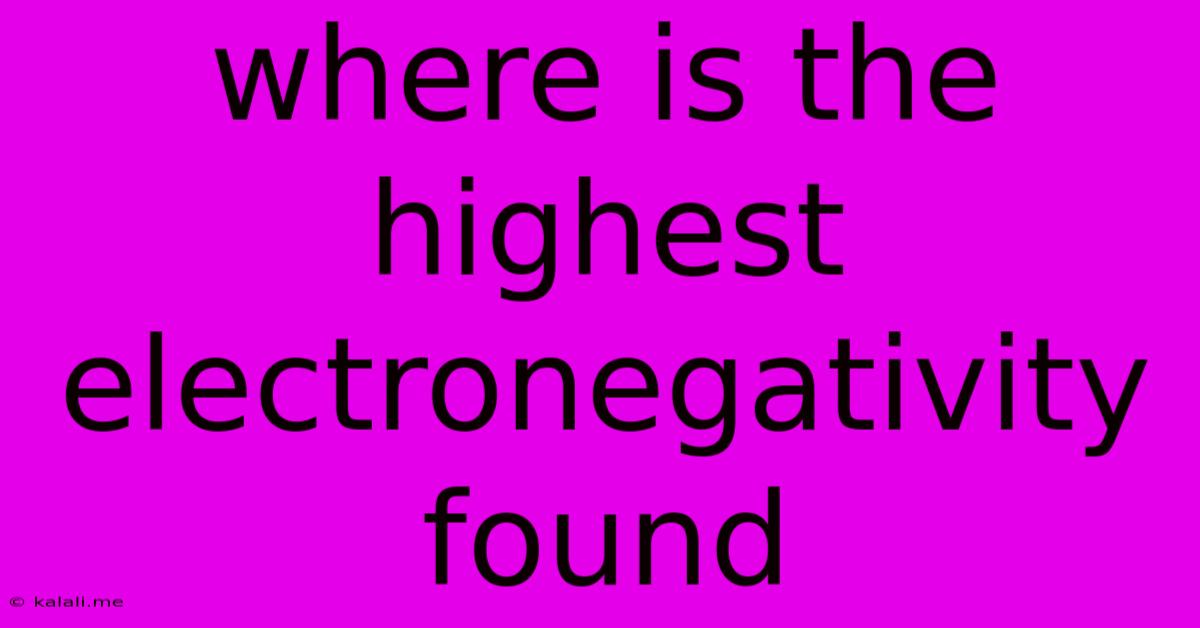Where Is The Highest Electronegativity Found
Kalali
May 09, 2025 · 3 min read

Table of Contents
Where is the Highest Electronegativity Found? Understanding the Periodic Trends
Electronegativity, a fundamental concept in chemistry, describes an atom's ability to attract electrons within a chemical bond. Understanding where the highest electronegativity is found is crucial for predicting the behavior of molecules and their reactivity. This article will explore the periodic trends of electronegativity, pinpoint the element with the highest value, and discuss the factors that contribute to this property.
What is Electronegativity?
Electronegativity isn't a directly measurable quantity like mass or charge. Instead, it's a relative measure, usually represented by the Pauling scale. This scale assigns values to elements, with higher values indicating a stronger attraction for electrons. The greater the difference in electronegativity between two atoms in a bond, the more polar that bond will be – meaning the electrons are more strongly drawn to the more electronegative atom.
Periodic Trends and Electronegativity
Electronegativity generally increases across a period (from left to right) and decreases down a group (from top to bottom) on the periodic table. This trend is primarily driven by two factors:
-
Effective Nuclear Charge: As you move across a period, the number of protons in the nucleus increases, increasing the positive charge experienced by the valence electrons. This stronger positive charge pulls the electrons more tightly, increasing electronegativity.
-
Atomic Radius: Moving down a group, the atomic radius increases. The valence electrons are further from the nucleus, experiencing a weaker attraction. This results in decreased electronegativity.
The Element with the Highest Electronegativity:
Based on the Pauling scale, fluorine (F) holds the title of the element with the highest electronegativity. Its value is approximately 4.0. This exceptionally high value stems from its small atomic radius and high effective nuclear charge. Being in the top right corner of the periodic table, it perfectly embodies the trends discussed above.
Why is Fluorine so Electronegative?
Fluorine's high electronegativity is a result of the combined effects of its small size and high nuclear charge. Its valence electrons are very close to the nucleus, experiencing a strong attractive force. This makes it exceptionally effective at pulling electrons towards itself in a chemical bond.
Other Highly Electronegative Elements:
While fluorine reigns supreme, other elements also exhibit high electronegativity. These are typically located near fluorine on the periodic table, including:
- Oxygen (O): Oxygen possesses a high electronegativity value, making it crucial in many chemical reactions and biological processes.
- Chlorine (Cl): Another halogen, chlorine, also displays significant electronegativity, contributing to its reactivity.
- Nitrogen (N): Nitrogen's electronegativity is notably high, impacting its role in organic molecules and atmospheric compounds.
Understanding Electronegativity's Importance:
Understanding electronegativity is vital for predicting:
- Bond polarity: The difference in electronegativity determines the nature of a chemical bond (ionic, covalent, or polar covalent).
- Molecular geometry: Electronegativity influences the shape of molecules.
- Chemical reactivity: Elements with high electronegativity often participate in reactions readily.
In conclusion, fluorine (F) possesses the highest electronegativity due to its small atomic size and high effective nuclear charge. This property plays a critical role in understanding chemical bonding, molecular properties, and chemical reactivity. By understanding electronegativity trends, we gain valuable insights into the behavior of atoms and molecules.
Latest Posts
Latest Posts
-
How To Calculate Ending Cash Balance
May 09, 2025
-
A Half Pound Is How Many Ounces
May 09, 2025
-
Cuanto Es Una Oz En Gramos
May 09, 2025
-
8 Out Of 18 As A Percentage
May 09, 2025
-
What Is The Color Of Bacteria
May 09, 2025
Related Post
Thank you for visiting our website which covers about Where Is The Highest Electronegativity Found . We hope the information provided has been useful to you. Feel free to contact us if you have any questions or need further assistance. See you next time and don't miss to bookmark.